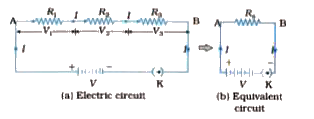Explain the series combination of resistors and derive the formula of equivalent resistance.Solution in Gujrati
Two or more than two resistors are said to be connected in series, if they are joined end to end and the same (i.e., total) current flows through each one of them when a potential difference is applied across the combination.

In figure (a), three resistors with resistance are connected in series across the points A and B. Here, current (1) flowing through each of the resistors is the same, but the total potential difference (p.d.) of the battery V is divided according to the resistances between the two ends of the respective resistors.
If the potential difference (p.d.) across respectively, then
Now, if one resistor with resistance , instead of these three resistors with resistances is connected in the circuit in such a way that the current flowing through the circuit remains the same as I, then is the resistance of the series combination. It is also called equivalent resistance of the combination (figure (b)).
Now, applying Ohm.s law,
From equation (12.8) and (12.9).
On applying Ohm.s law to the three resistors separately, we have
... ...(12.11)
Thus, the equivalent resistance of the series combination is equal to the sum of the individual resistances and is thus greater than any of the individual resistances.
[Note: If n resistors with resistances are connected in series,
Topper's Solved these Questions
- ELECTRICITYBook:KUMAR PRAKASHANChapter:ELECTRICITYExercise:QUESTIONS AND ANSWERS (INTEXT QUESTIONS)
Explore 25 Videos
- ELECTRICITYBook:KUMAR PRAKASHANChapter:ELECTRICITYExercise:QUESTIONS AND ANSWERS (TEXTBOOK ILLUSTRATIONS)
Explore 14 Videos
- MAGNETIC EFFECTS OF ELECTRIC CURRENT Book:KUMAR PRAKASHANChapter:MAGNETIC EFFECTS OF ELECTRIC CURRENT Exercise:VALUE BASED QUESTIONS WITH ANSWERS
Explore 15 Videos
Similar Questions
What does an electric circuit mean?
View SolutionA current of 0.5 A is drawn by a filament of an electric bulb for 10 minutes. Find the amount of eletric charge that flows through the circuit.
View SolutionShalini and his brother Amey observed a water-pump working , Shalini inquired how an electric motor works . Amey collected different parts of an electric motor e.g., field - magnets , cabon- brushes , armature , battery , switch, connecting wire , split - rings , etc, and showed them to Shalini . Amey then explained how an armature could rotate.
State the principle how an electric motor to works .
View Solutionश्रेणी क्रम मे प्रतिरोधों को किस प्रकार जोड़ा जाता है? प्रतिरोधों के श्रेणी क्रम मे संयोजन के लिए सूत्र का निगमन कीजिए !
अथवा प्रतिरोधों को श्रेणी क्रम मे जोड़ दिया जाए तो इस संयोग के लिए उनके तुल्य प्रतिरोध का सूत्र स्थापित कीजिए !
View Solutionक्या श्रेणी क्रम में संयोजन में प्रतिरोध का समतुल्य प्रतिरोध संयोजन में भाग लेनेवाले किसी एक भी प्रतिरोधक के प्रतिरोध से कम हो सकता है?
View SolutionExplain series and parallel combination of capacitors. Derive the formula for equivalent capacitance in each combination.
View SolutionWhat is series combination of capacitors. Derive the formula for equivalent capacitance in series combination.
View Solutionप्रतिरोधों के (i ) श्रेणीक्रम तथा (ii ) समान्तर - क्रम संयोजनों में तुल्य - प्रतिरोधों के लिए सूत्र स्थापित कीजिए तथा दोनों संयोजनों के निष्कर्ष लिखिए ।
View SolutionExplain the equivalent resistance of a series and parallel resistor network.
View SolutionObtain an expression for equivalent resistance of two resistors connected in a series combination.
View SolutionExplain the equivalent resistance of a series and parallel resistor network.
View SolutionExplain the equivalent resistance of a series and parallel resistor network.
View SolutionDerive expression for equivalent resistance of a parallel combination of resistances.
(b) Calculate the ratio of equivalent resistance for a series combination of n number of identical resistors to the parallel combination of the same type of n number of resistors.
View SolutionExplain series connection of resistors. Derive equation of equivalent resistance (RS).
View SolutionDerive the formula of equivalent resistance of series combination of resistors.
View Solution

